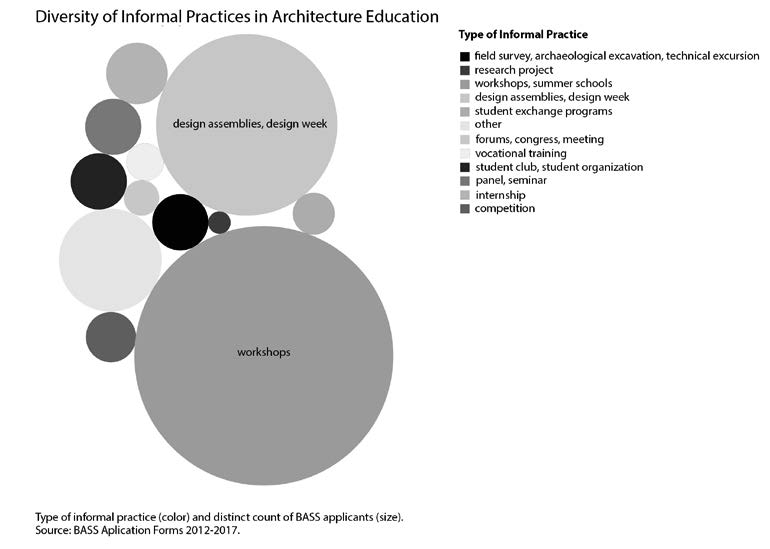The Case of Betonart Architecture Summer School
Downloads
DOI:
https://doi.org/10.51588/eaaeacp.57Keywords:
architecture education, informal education, workshops in architecture, summer school, Betonart Architectural Summer SchoolAbstract
The way of learning and performing practice, the tools and methods that are being used for it and the spaces that these processes take place are shifting with the change of information and technology. Under these circumstances architectural education has faced difficulties in being up to date in particular about curriculum, program and physical requirements. While instant solutions give instant results, it is inevitable that rooted solutions will be encountered to keep up with this rapid change. For this reason, countless “informal education” activities are being implemented, such as competitions, workshops, assemblies, forums, publications, etc. This paper focuses on BASS (Betonart Architectural Summer School) as a case to understand the motives of participating in such activities from the perspective of architectural students. It tries to demonstrate that students are aware of the importance of informal educational activities, furthermore they are increasingly demanding.
How to Cite
Published
Issue
Section
License
Copyright (c) 2020 Neslihan İmamoğlu

This work is licensed under a Creative Commons Attribution 4.0 International License.
References
Becan, Ç. (2019, 11 8). Betonart Mimarlık Yaz Okulu Yuvarlak Masa Toplantısı Ses Kaydı. (B. Dergisi, Interviewer)
Ciravoğlu, A. (2001). Workshop’ların Mimarlık Eğitimine Katkısına ilişkin Bir İnceleme: EASA 20[00] Örneği. Mimarist, 100–105.
Collective. (2014). Bağlantı, Betonart Mimarlık Yaz Okulu Afyon 2014. (N. İmamoğlu, Ed.) Ankara: TÇMB.
Collective. (2012). Betonart Mimarlık Yaz Okulu, Kesişme. Ankara: TÇMB.
Collective. (2017). Bir Şans Daha Ver!, Betonart Mimarlık Yaz Okulu, Bursa, 2017. (N. İ. K. Bilge Erdem, Ed.) Ankara: TÇMB.
Collective. (2013). Ütopya Kent, Betonart Mimarlık Yaz Okulu, 2–10 Temuz, Burhaniye. (H. K. Sharma, Ed.) Ankara: TÇMB.
İmamoğlu, N. (2019). Enformel Mimarlık Çalışmalarında Öğrenci Motivasyonunun Araştırılması: Betonart Mimarlık Yaz Okulu Örneği. İstanbul: YTÜ FBE Yayımlanmamış YL Tezi.
Nicol, D.; Pilling, S. (2000). Architectural Education and The Profession: Peraring for the Future. In D. V. Nicol, Changing Architectural Education: Towards a New Professionalism (pp. 1–21). London: Spon Press.
PAB. (2019). Çoğulculuğu Önemseyen Bir Deneyim. Betonart (63), 10–13.Rogers, A. (2004). Non-Formal Education: Flexible Schooling or Participatory Education (Vol. CERC Studies in Comparative Education). USA: Springer, Kluwer Academic Publishers.
Salama, A. (1995). New Trends in Architectural Edcucation: Designing the Design Studio. Raleigh: Tailored Text.
Survey, A. P. (2001–2002). APME Pan European Survey.
Teymur, N. (1995). Elma, Armut ve Müfredat: Mimarlık Eğitiminin daha çözümsel tartışılabilmesi için kuramsal bir yöntem denemesi. Mimarlık ve Eğitimi Forum 1: Nasıl Bir Gelecek? (p. 207). İTÜ.
Vardiya/Shift Curatorial Team. (n.d.). Vardiya / SHift. Retrieved 11 19, 2019, from http://vardiya.iksv.org/
Yürekli, H., Yürekli, F. (2004). Mimarlık Eğitimi: Çözüm 5 Yıl mı? In: Mimarlık Bir Entelektüel Enerji Alanı. İstanbul: YEM yayın.
Werquin, P. (2008). Lifelong Learning in Europe. OECD, Recognition of non-formal and informal learning in OECD countries: A very good idea in jeopardy. Paris: OECD.





